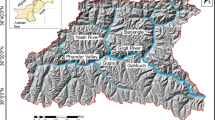Abstract
Detailed Landsat imagery interpretation was carried out in Dhansiri Valley, Lower Assam, employing the standard visual interpretation techniques. Optico-electronic analysis using 1215 Video Image Processer was also carried out. Edge enhancement of the imagery using photographic methods was found to sharpen lineaments to a great extent.
As many as fifteen localities have been identified as “anomalies” reflecting possible subsurface structures. The delineation is based on different factors including tone, texture, drainage etc.
Prominent structural trends delineated are in NE-SW and ENE-WSW directions. The NE-SW trending Borholla-Mikir hills fault zone divided the valley into two distinct structural units, the relatively shallower northern sector dominated by the ENE-WSW trending faults and the southern sector comprising the Dhansiri-Diyung flood plains dominated by tne NE-SW trending faults.
Similar content being viewed by others
References
Mathur, L.P. and Evans, P. 1964. Oil in India, International Geological Congress, Twenty second session, India
Murthy, K.V S., Kumar S. and Ray, D. 1979. Hydrocarbon prospects of Dhansiri Valley-possible stratigraphic trap. IPE, ONGC unpublished report
Roy, T.K. and Mukherjee, M.K. 1976. Geology and Petroleum prospects of Mikir Hills, Assam. ONGC report unpublished
Author information
Authors and Affiliations
About this article
Cite this article
Badhe, S. Landsat analysis of Dhansiri valley. Jour. Photo-Int. & Remote Sensing 9, 13–19 (1981). https://doi.org/10.1007/BF02991459
Issue Date:
DOI: https://doi.org/10.1007/BF02991459




